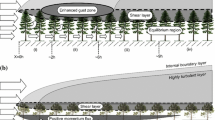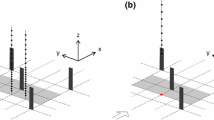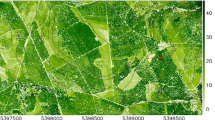Abstract
Experimental investigations in an atmospheric boundary layer wind tunnel were carried out in order to study both the influence of the windward edge structure and the stand density on the flow characteristics near the canopy top of forest edges. For the edge structure investigation, two different types of forest edges were used. The taper angle was varied three times for both edge types, and all tapered edges were combined with both dense and sparse forest stands. In addition, a configuration was investigated where the airflow in the trunk space of the dense forest was blocked completely by an impermeable wall. In order to study the influence of stand density, forest stands were varied three times by removing whole rows of the originally dense model forest. The measurements show that a forest edge induces strong disturbances in the flow field at the near-edge region leading to an increased momentum transfer and to an increased wind loading on trees. The region of significant disturbances extends to a distance of about eight tree heights. Both edge density and taper angle determine the amount of volume influx through the edge, which seems to be primarily responsible for the flow field properties near the canopy top. It was found that for sparse forest stands, sloping tapered edges reduce the wind velocities nearest to the canopy. It could also be shown that the positive skewness of the near-canopy longitudinal velocity distribution is diminished with decreasing taper angle indicating that higher wind velocity fluctuations are reduced.















Similar content being viewed by others
References
Bieder U, Schatz A, Schöpfer T (1992) Modelling the heat and mass transport to forest edges—a contribution to the EUROTRAC subproject BIATEX. BIATEX-Jahresbericht
Dupont S, Brunet Y (2008) Impact of forest edge shape on tree stability: a large-eddy simulation study. Forestry 81(3):299–316
Eurocode 1 (2005) Einwirkungen auf Tragwerke—Teil 1-4: Allgemeine Einwirkungen, Windlasten; Deutsche Fassung EN 1991-1-4:2005
Frank C, Ruck B (2007) Windkanalstudie zur Strömung in Waldlichtungen. Proceedings 15. Fachtagung “Lasermethoden in der Strömungsmesstechnik”, Rostock, 9.1–9.9
Frank C, Ruck B (2008) Numerical study of the airflow over forest clearings. Forestry 81(3):259–277
Frank C, Ruck B (2009) About the influence of the stand density on the flow characteristics at forest edges. Proceedings of the 2nd international conference on wind effects on trees, Freiburg
Fritzsche K (1933) Sturmgefahr und Anpassung. Tharandter Forstliches Jahrbuch 84:1–94
Gardiner B, Stacey G (1996) Designing forest edges to improve wind stability. Forestry commission technical paper no 16. Forestry Commission, Edinburgh
Green SR, Grace J, Hutchings NJ (1995) Observations of turbulent air flow in three stands of widely spaced Sitka spruce. Agric For Meteorol 74:205–225
Hengst E (1985) Hinweise zur Stabilisierung des Waldaufbaus nach neuen Grundlagenerkenntnissen. Wissenschaftliche Zeitschrift der Technischen Universität Dresden 34(1):181–185
Irvine MR, Gardiner BA, Hill MK (1997) The evolution of turbulence across a forest edge. Boundary Layer Meteorol 84:467–496
Kruijt B, Klaassen W, Hutjes RWA (1995) Edge effects on diffusivity in the roughness layer over a forest’. In: Coutts MP, Grace J (eds) Proceedings of the IUFRO conference on wind and wind related damages to trees, Cambridge University Press, Edinburgh, pp 60–70
Li Z, Lin JD, Miller DR (1990) Air flow over and through a forest edge: a steady-state numerical simulation. Boundary Layer Meteorol 51:179–197
Liu J, Chen JM, Black TA, Novak MD (1996) Modelling of turbulent air flow downwind of a model forest edge. Boundary Layer Meteorol 77:21–44
Mitscherlich G (1974) Sturmgefahr und Sturmsicherung. Schweizerische Zeitschrift Forstwesen 125:199–216
Morse AP, Gardiner BA, Marshall BJ (2002) Mechanisms controlling turbulence development across a forest edge. Boundary Layer Meteorol 103:227–251
Novak MD, Warland JS, Orchansky AL, Ketler R, Green S (2000) Wind tunnel and field measurements of turbulent flow in forests. Part I: uniformly thinned stands. Boundary Layer Meteorol 95:457–495
Plate EJ (1995) Windprofile in der Gebäudeaerodynamik. In: Plate EJ (ed) Windprobleme in dichtbesiedelten Gebieten, WTG-Berichte, vol 3. Windtechnologische Gesellschaft, Aachen, pp 7–26
Raynor GS (1971) Wind and temperature structure in a coniferous forest and a contiguous field. For Sci 17:351–363
Rottmann M (1986) Wind- und Sturmschäden im Wald. J.D. Sauerländer’s Verlag, Frankfurt am Main
Ruck B, Adams E (1991) Fluid mechanical aspects in the pollutants transport to coniferous trees. Boundary Layer Meteorol 56:163–195
Ruck B, Schmitt F (1987) Flow characteristics around coniferous trees. Proceedings of the international conference on fluid mechanics, Peking, China, pp 1113–1119
Ruck B, Schmitt F, Kihm G (1988) Aspekte zum Schadensverlauf in Waldbeständen mit windexponierten Träufen. Forst und Holz 43(10):242–245
Shaw RH, Tavangar J, Ward DP (1983) Structure of the Reynolds stress in a canopy layer. J Clim Appl Meteorol 22:1922–1931
Wölfle M (1942) Windverhältnisse im Walde, III. Einfluß von Unter- und Zwischenstand auf die Windverhältnisse über der Bestandsrandzone. Forstw Centralblatt 64(8):169–182
Yang B, Shaw RH, Paw U KT (2006) Wind loading on trees across a forest edge: a large eddy simulation. Agric For Meteorol 141:133–146
Acknowledgments
These investigations were performed within the project ‘Improving the storm stability of forest stands’ that is part of the RESTER-network (‘Strategies for the reduction of the storm damage risk for forests’) within the research programme ‘Challenge climate change’. The authors would like to thank the Ministry for the Environment of the German federal state Baden-Württemberg for the financial support of this project.
Author information
Authors and Affiliations
Corresponding author
Additional information
Communicated by J. Müller.
This article belongs to the special issue ‘Wind Effects on Trees’.
Rights and permissions
About this article
Cite this article
Ruck, B., Frank, C. & Tischmacher, M. On the influence of windward edge structure and stand density on the flow characteristics at forest edges. Eur J Forest Res 131, 177–189 (2012). https://doi.org/10.1007/s10342-010-0451-7
Received:
Revised:
Accepted:
Published:
Issue Date:
DOI: https://doi.org/10.1007/s10342-010-0451-7




